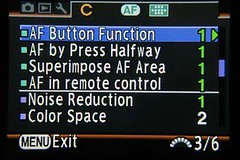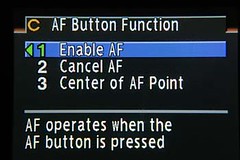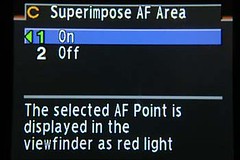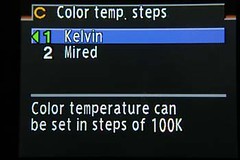I'm finally getting around to writing part 2 of the custom menu settings. I've been busy all week and the few moments I've had were spent with family or taking photos (usually at night after everyone is in bed).
Part 2 is going to cover:
AF Button Function
AF by Press Halfway
Superimpose AF Area
AF in remote control
Noise Reduction
Color Space
Color temp. steps
So lets get going.
The AF (auto focus) button can be programmed to work in 3 different ways.
Enable focus is kind of a misnomer. One would think if you were in manual focus mode you would press the AF button and auto focus would be enabled but this is not the case. What this setting does is cause the camera to actually focus the lens just like you do normally when pressing the shutter button halfway.
The cancel autofocus setting will allow you to turn off autofocus for what ever reason. You have to continuously hold the button to keep the autofocus turned off.
The third setting, center of AF point, allows you to quickly switch from any of the focus points (in SEL mode) to the center focus point. This is faster than trying to use the 4way controller to get back to the center point
AF by press halfway is a pretty self explanatory setting, it either turns shutter release halfway focus on or off.
This can be useful if you want autofocus to be on but want to select it with the AF button instead. This allows you to set the focus with the AF button and then keep firing shots with the shutter release without having the camera re-focus between each shutter press. Think portrait photography where the person is staying close to the focal plane. If you are shooting with a large aperture you may want to still consider focusing on the eye between each take so you know for sure the focus is bang on. If you're shooting f8 or higher for a group shot then the focal plane will not move enough between takes to worry about and thus this setting will be very useful in speeding up the process.
If you like lights and bells and whistles then you might like the superimpose AF area function. If turns on a red LED light in the view finder to show you what focus point is being used. It's pretty useful I guess so you can tell if the wrong point is used when in AUTO or SEL focus point mode. If you're using center point then it's really not needed.
AF in remote control is useful if you don't want the camera to focus when using the infrared remote control.
Consider taking a photo where you precisely set the focus and then jump into the scene (or not) before releasing the shutter.
Noise reduction is a feature that is used during long exposures of 1 second or more. What the camera does is after the long exposure it takes another long exposure (the same length) of complete darkness and compares the results. Any areas in the black image that match the pixel of the real image are considered noise and the camera then tries to match that pixel to the surrounding pixels to reduce the appearance of noise. It's a good start in the process of reducing sensor noise.
Color space sets the camera to use sRGB or AdobeRGB. AdobeRGB has a better color palette for printing while sRGB has a better palette for viewing on a computer monitor.
If all you are doing is emailing your photos then sRGB is fine. If you want to make prints then set to Adobe.
You can always convert from Adobe to sRGB in post processing if you want to both print and post on the internet.
Color temp steps are used when manually setting the color temperature with the Fn button. This is a bit weird because it really only adjusts the steps and does not change the scale from kelvin to mireds. Why they had to use two different scales for each step setting is beyond me. Here's the scoop. It appears the kelvin scale is not a very linear scale so a change of 500K at one of the scale is not the same as a 500K at the other end of the scale. Mired is used for a more linear adjustment using filters. It's complicated to me too so don't worry about it too much.
Read thisand this, it may not may not help you understand a little more.
The settings can be either 100 kelvin or 20 mired. 100K is the same as 1,000,000/100 or 10,000M. And 20M is the same as 1,000,000/20 or 50,000K.
So this boils down to the steps being 100K and 50,000K or 10,000M and 20M. Are you confused yet?! I am!
If this is confusing you (as it is me) just leave the setting on Kelvin and forget about it.
I'm sure someone could write a dissertation about it and we'd still be no closer to understanding why Pentax choose to do the steps like they did.
OK so there ends part 2. It was a little shorter than I had envisioned, so I'll get started on part 3 and be that much closer to completing the custom menu settings.
Next article.









2 comments:
Thank you for sharing your know how on K10D. I just got this camera and still fiddling and trying all the buttons. Looking forward to read more from your day to day K10 experience.
Good reeading your post
Post a Comment